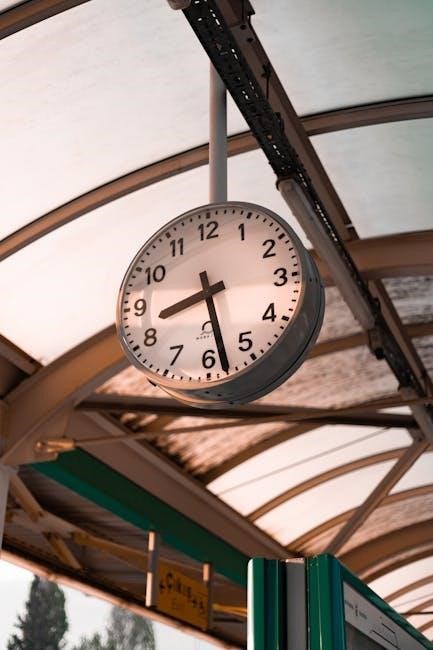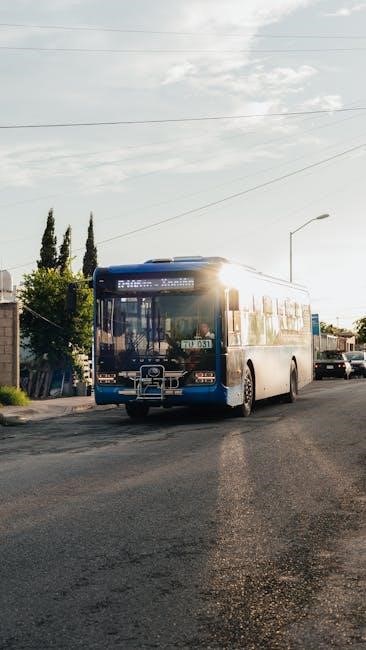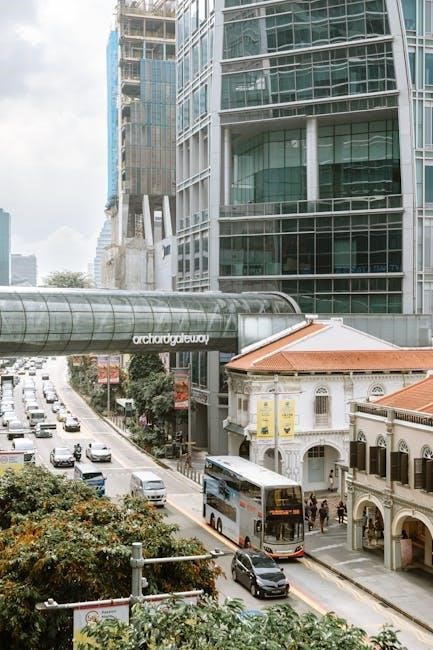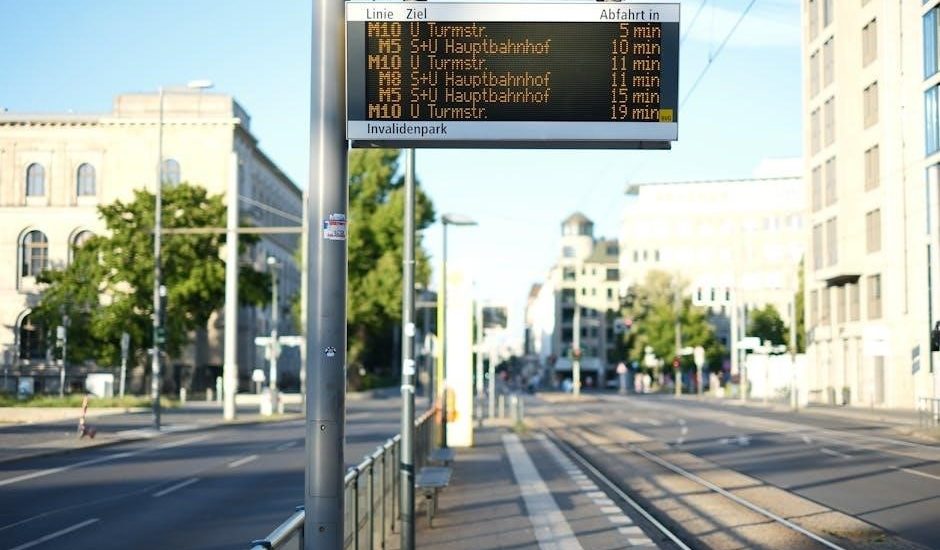The D6 Bus Schedule PDF provides essential information about the route, including timetables, stops, and service updates, helping passengers plan trips efficiently․
1․1 Overview of the D6 Bus Route
The D6 bus route operates between Loughboro Rd NW & Sibley Hospital and 17th St NW & I St NW, serving 45 stops in Washington D․C; It connects key locations like Farragut Square and Stadium-Armory, offering frequent service every 15-20 minutes during peak hours and 20-30 minutes off-peak․ The route is essential for commuters and residents, providing reliable transportation across the city․
1․2 Importance of the D6 Bus Schedule PDF
The D6 Bus Schedule PDF is a vital resource for passengers, offering comprehensive details about the route, stops, and timetables․ It helps users plan trips efficiently, ensuring punctuality and convenience․ The PDF includes real-time updates, service alerts, and maps, making it indispensable for daily commuters․ By downloading the PDF, passengers can access offline schedules, track bus arrivals, and navigate the route seamlessly․ This tool is especially useful for those without internet access, providing reliable information to enhance travel planning and reduce wait times․ It also supports environmental sustainability by reducing paper waste through digital access․

D6 Bus Schedule Details
The D6 Bus Schedule PDF outlines the route’s operational details, including service hours, frequency, and stops, providing a clear overview for efficient travel planning․
2․1 Weekday Schedule
The D6 bus operates on weekdays with a consistent schedule, providing service from 9:05 AM to 3:29 PM․ Buses run every 15-20 minutes during peak hours and less frequently during off-peak times․ The route includes 45 stops, starting from Loughboro Rd NW & Sibley Hospital and ending at 17th St NW & I St NW․ Passengers can track arrival times using the Moovit app or by downloading the PDF schedule, which details exact departure and arrival times for each stop․ This schedule ensures reliable transportation for commuters, with adjustments during peak hours to accommodate higher demand․
2․2 Weekend Schedule
On weekends, the D6 bus schedule operates with reduced frequency compared to weekdays․ Buses typically run every 30-40 minutes, with service starting later in the morning and ending earlier in the evening․ The route remains the same, covering all 45 stops from Loughboro Rd NW & Sibley Hospital to 17th St NW & I St NW․ Passengers can access the weekend timetable via the PDF schedule or through the Moovit app, ensuring they can plan their trips accordingly․ Weekend schedules may vary slightly due to service alerts or temporary detours, so checking updates before travel is recommended․
2․3 Peak Hour Frequency
During peak hours, the D6 bus operates more frequently to accommodate increased passenger demand․ Buses run every 15 minutes, ensuring shorter wait times for commuters․ Peak hour service typically occurs during early mornings and late afternoons on weekdays․ The route maintains its full coverage, connecting key stops like Loughboro Rd NW & Sibley Hospital to Farragut Square․ Additional shorter routes are introduced during peak times, such as trips between Farragut Square and Stadium-Armory or Sibley Hospital, to enhance efficiency․ Passengers can rely on the PDF schedule or real-time apps like Moovit for precise peak hour timings and service updates․
2․4 Off-Peak Hour Frequency
During off-peak hours, the D6 bus operates less frequently to match lower passenger demand․ On weekdays, buses run every 20 minutes, while weekends see longer intervals of 30 to 40 minutes․ This adjustment ensures efficient service without unnecessary trips․ The full route remains active, connecting all stops from Loughboro Rd NW & Sibley Hospital to Farragut Square․ Passengers can use the PDF schedule or apps like Moovit for exact off-peak timings, ensuring they plan their trips accordingly․ The consistent service pattern makes it reliable for those traveling outside peak times․
D6 Bus Route Map
The D6 Bus Route Map visually outlines the entire journey, showing the path from Loughboro Rd NW & Sibley Hospital to Farragut Square, including all key stops․
3․1 Start and End Points
The D6 bus route begins at Loughboro Rd NW & Sibley Hospital and concludes at 17th St NW & Farragut Square․ This route connects key areas, including Stadium-Armory and Dupont Circle, ensuring convenient travel across Washington, D․C․ The D6 bus operates with a total of 45 stops, offering regular service throughout the day․ Whether commuting for work or exploring the city, the D6 route provides a reliable option for passengers․ The schedule is designed to accommodate both peak and off-peak hours, making it accessible for various travel needs․
3․2 Key Stops Along the Route
The D6 bus route includes several key stops that serve as major transfer points or access to prominent locations․ Stadium-Armory is a significant stop, offering connections to Metrorail services․ Dupont Circle and Farragut Square are central hubs for both commuters and visitors․ Additionally, Sibley Hospital is a crucial stop for those needing medical services․ These stops ensure that passengers can easily reach various parts of Washington, D․C․, making the D6 route a convenient option for daily commutes and explorations․
3․3 Route Map in PDF Format
The D6 bus route map is available in PDF format, providing a visual guide to the entire journey․ It highlights key stops, such as Stadium-Armory, Dupont Circle, Farragut Square, and Sibley Hospital․ The map also shows connecting routes and nearby landmarks, making it easier for passengers to navigate․ Features include a detailed layout of the route, transfer points, and service alerts․ Downloading the PDF ensures access to this information offline, helping users plan their trips efficiently and stay informed about any schedule changes or detours․

Accessing the D6 Bus Schedule PDF
The D6 Bus Schedule PDF can be downloaded from official WMATA sources or accessed via the Moovit app for offline use, ensuring convenient trip planning․
4․1 Downloading the PDF from Official Sources
The D6 Bus Schedule PDF can be easily downloaded from the official WMATA website․ Visit the WMATA portal and navigate to the “Schedules” section․ Select the D6 route from the list of available options․ Choose the desired schedule format, and click the download button to save the PDF․ Ensure you have Adobe Acrobat Reader installed to view the document․ This method guarantees you receive the most accurate and up-to-date schedule information․ Always download from official sources to avoid outdated or incorrect timetables․ This approach ensures reliability and convenience for planning your trips effectively․
4․2 Using the Moovit App for Offline Access
The Moovit App offers a convenient way to access the D6 bus schedule offline․ Download the PDF timetable directly through the app, ensuring you have schedules readily available without an internet connection․ Moovit also provides real-time tracking, allowing you to monitor the bus’s location and arrival times․ This feature is especially useful for planning trips efficiently․ By using the app, you can avoid delays and stay informed about service changes or disruptions․ The Moovit App is a reliable tool for navigating the D6 route, combining offline access with live updates for a seamless travel experience․

Operational Details of the D6 Bus
The D6 bus operates with 45 stops, running every 22-25 minutes during peak hours and less frequently off-peak, ensuring reliable service throughout the day․
5․1 Total Number of Stops
The D6 bus route features a total of 45 stops, ensuring comprehensive coverage across key areas from Loughboro Rd NW & Sibley Hospital to 17th St NW & I St NW․
5․2 Service Hours
The D6 bus operates with varied service hours depending on the direction․ Eastbound trips to Farragut Square run from 9:05 AM to 3:29 PM, while Westbound trips to Dupont Circle start at 12:00 AM and end at 11:48 PM․ Weekend schedules differ slightly, with reduced frequencies․ Peak hours see buses every 15-20 minutes, while off-peak hours extend to 30-40 minutes․ This ensures consistent coverage throughout the day, catering to both commuters and casual riders․
5․3 Bus Frequency
The D6 bus frequency adjusts throughout the day to match demand․ Peak hours see buses every 15-20 minutes, while off-peak hours reduce to every 25-30 minutes․ Late-night services operate every 35-40 minutes, optimizing efficiency․ This scheduling ensures reliable service without unnecessary stops․ Apps like Moovit offer real-time tracking and schedule details, helping passengers plan trips effectively․ The frequency adjustments help maintain service consistency and meet rider needs across different times of the day․

D6 Bus Service Changes
Recent updates include temporary detours and alerts, such as the Vans Warped Tour affecting 17th St NE at C St․ Check WMATA․com for details and plan accordingly․
6․1 Recent Updates to the Schedule
Recent updates to the D6 bus schedule include adjustments to peak hour frequencies, with buses now operating every 22-25 minutes․ Two shorter routes have been added during peak hours, one from Farragut Square to Stadium-Armory and another to Sibley Hospital․ These changes aim to improve service reliability and reduce congestion․ Additionally, temporary detours, such as the one on 17th St NE due to the Vans Warped Tour, have been implemented․ Passengers are advised to check WMATA․com for the latest information to plan their trips effectively․
6․2 Temporary Detours and Alerts
Temporary detours and alerts for the D6 bus route are occasionally implemented due to events or construction․ For instance, westbound buses on 17th St NE at C St are on detour until 9:00 AM on June 16, 2025, due to the Vans Warped Tour․ Passengers should expect possible delays and check WMATA․com for detailed routing information․ Real-time updates can also be accessed through the Moovit app or WMATA’s service alerts․ Staying informed ensures a smooth journey, as temporary changes may alter stop locations or arrival times without prior notice․

Using the D6 Bus Schedule PDF
The D6 Bus Schedule PDF is a handy tool for tracking real-time bus locations, planning trips, and accessing route maps, ensuring a seamless travel experience․
7․1 How to Read the Schedule
Reading the D6 bus schedule PDF involves understanding the layout, which typically includes arrival times, route maps, and service alerts․ The schedule is divided into sections for weekdays, weekends, and peak hours․ Each stop is listed with corresponding arrival times, making it easy to plan your trip․ Symbols or notes indicate special alerts or deviations․ By matching your location and destination, you can determine the best time to catch the bus․ Additionally, the PDF often includes a route map to visualize your journey․ This feature helps passengers navigate efficiently and stay informed about any service changes or detours․
7․2 Planning Your Trip
Planning your trip with the D6 bus schedule PDF involves identifying your start and end points, then matching them with the corresponding times․ Use the route map to visualize your journey and ensure your stops are correctly aligned․ Check peak and off-peak hour frequencies to determine the best departure time․ Additionally, use real-time tracking tools like the Moovit app to monitor bus locations․ Always review service alerts for potential detours or delays․ By combining the PDF schedule with real-time updates, you can plan your trip efficiently and arrive at your destination on time․ This approach ensures a smooth and stress-free travel experience․
7․3 Tracking the Bus in Real Time
Tracking the D6 bus in real time enhances your travel experience by providing up-to-the-minute updates․ Use the Moovit app to monitor the bus’s location and estimated arrival time at your stop․ Real-time tracking helps you adjust your schedule if there are delays or detours․ Service alerts within the app notify you of any disruptions, ensuring you’re always informed․ Combine this feature with the PDF schedule for a seamless journey․ By staying connected, you can reduce wait times and make informed decisions, making your commute more efficient and stress-free․

D6 Bus Stops and Connections
The D6 bus route includes 45 stops, connecting key locations like Sibley Hospital and Farragut Square․ It links to other bus routes, making transfers convenient for passengers․
8․1 List of All Stops
The D6 bus route includes 45 stops, starting from Loughboro Rd NW & Sibley Hospital and ending at 17th St NW & I St NW (East)․ Key stops include Stadium-Armory, Farragut Square, and Dupont Circle․ The route covers major landmarks and transfer points, ensuring convenient travel across Washington D․C․ Passengers can view the full list of stops in the D6 bus schedule PDF, available for download from official sources․ This comprehensive list helps riders plan their journeys efficiently, whether commuting to work or exploring the city․
8․2 Connecting Bus Routes
The D6 bus route connects with several other Metrobus lines, including D8, E2, and F1, offering passengers seamless transfers․ Key transfer points like Farragut Square and Stadium-Armory enable riders to switch lines easily․ This network enhances travel efficiency, allowing passengers to reach destinations beyond the D6 route․ The D6 bus schedule PDF provides details on connecting routes and transfer locations, helping riders plan their journeys effectively․ By leveraging these connections, passengers can explore more of Washington D․C․ with minimal disruptions․
8․3 Nearest Stops to Key Landmarks
The D6 bus schedule PDF highlights stops near major landmarks like Farragut Square, Stadium-Armory, and Sibley Hospital․ These stops provide easy access to key destinations, making navigation convenient for both tourists and regular commuters․ The PDF includes maps pinpointing these stops, ensuring riders can locate them quickly․ This feature is particularly useful for planning visits to popular spots or connecting to other transit lines efficiently․ By referencing the PDF, passengers can identify the closest D6 stops to their desired landmarks, streamlining their travel experience in Washington, D․C․

Fare Information
The D6 bus fare details are outlined in the PDF, including regular fares, discounts for seniors and students, and payment options like SmarTrip cards․ Detailed fare structures are provided․
9․1 Regular Fares
Regular fares for the D6 bus are competitively priced, offering affordable travel options․ The base fare is $2․00, with options to pay using cash or SmarTrip cards․ Seniors and disabled passengers enjoy reduced fares, while children under five ride free․ Exact change is recommended for cash payments, and transfers are available for up to two hours․ The PDF schedule includes detailed fare information, ensuring passengers are well-informed before their journey․ This straightforward pricing makes commuting convenient and budget-friendly for all riders․
9․2 Special Fares and Discounts
The D6 bus offers various discounted fare options to make travel more affordable․ Senior citizens, disabled passengers, and students with valid ID can enjoy reduced fares․ Military personnel and veterans also qualify for special rates․ Additionally, the Guaranteed Ride Home program provides free trips for eligible commuters․ Passengers can use SmarTrip cards for convenient fare payments and transfers․ These discounts are designed to support diverse passenger needs, ensuring accessible and cost-effective transit for everyone; The PDF schedule details all available discounts, helping riders plan their journeys with ease and save money․

Service Alerts and Updates
Passengers can access real-time service alerts and updates through official sources or apps like Moovit․ These updates inform riders about delays, detours, or schedule changes, ensuring informed travel decisions․
10․1 How to Stay Informed
To stay informed about D6 bus service alerts, passengers can subscribe to WMATA notifications, use the Moovit app for real-time updates, or visit the official website․ Additionally, following WMATA on social media platforms like Twitter provides timely updates on service disruptions, schedule changes, and detours․ Riders can also check digital signage at bus stops or use the WMATA service status page for the latest information․ These tools help ensure that passengers are well-prepared for their journeys and can adapt to any unexpected changes in the schedule․ Regularly checking these sources is essential for a smooth commuting experience․
10․2 Impact of Service Alerts on the Schedule
Service alerts, such as temporary detours or unexpected disruptions, can directly impact the D6 bus schedule, causing delays or changes in arrival times․ These alerts may result from events like road closures, inclement weather, or special events, such as the Vans Warped Tour, which caused detours on 17th St NE․ Passengers should check WMATA’s service status page or the Moovit app for real-time updates to adjust their travel plans accordingly․ Timely notifications help riders anticipate delays and plan alternative routes, ensuring minimal disruption to their journeys․ Staying informed is crucial for navigating service-related changes effectively․ Regular updates are provided to keep passengers prepared․

Benefits of the D6 Bus Schedule PDF
The D6 Bus Schedule PDF offers convenience for passengers by providing detailed timetables and route maps, while also promoting environmental sustainability by reducing the need for printed materials․
11․1 Convenience for Passengers
The D6 Bus Schedule PDF is designed to enhance passenger convenience, offering a downloadable and printable format for easy access․ It provides detailed timetables, route maps, and service alerts, enabling users to plan their trips efficiently․ The PDF is accessible offline, making it ideal for areas with limited internet connectivity․ By having all the necessary information in one place, passengers can quickly identify the best routes, track bus arrivals, and stay informed about any service changes․ This accessibility ensures a seamless and stress-free travel experience for commuters and occasional riders alike․
11․2 Environmental Benefits
The D6 Bus Schedule PDF promotes eco-friendly practices by reducing paper usage․ Instead of printing schedules, passengers can access the information digitally, minimizing environmental impact․ This digital approach aligns with sustainability goals by lowering carbon emissions from paper production and distribution․ Additionally, efficient route planning encouraged by the PDF helps reduce fuel consumption, as buses operate on optimized schedules․ By encouraging public transportation, the PDF supports lower greenhouse gas emissions from private vehicles, fostering a greener urban environment and promoting sustainable commuting options for all passengers․
The D6 Bus Schedule PDF is a valuable resource for passengers, offering convenience, essential details, and environmental benefits by reducing paper usage and promoting efficient travel planning․
12․1 Summary of Key Points
The D6 bus schedule PDF provides a comprehensive overview of the route, including start and end points, key stops, and service hours․ It details peak and off-peak frequencies, ensuring passengers can plan their trips efficiently․ The PDF also highlights the importance of staying informed about service changes and offers tips for using the schedule effectively․ By downloading the PDF, users can access essential information offline, making it a valuable resource for both regular and occasional riders․ This guide helps passengers navigate the D6 route seamlessly, ensuring a smooth and stress-free travel experience․
12․2 Final Tips for Using the D6 Bus Schedule PDF
Download the PDF from official sources or via the Moovit app for offline access․ Plan your trip by checking arrival times and key stops in advance․ Use real-time tracking to monitor bus locations and avoid delays․ Regularly check for service alerts and updates to stay informed about schedule changes․ Familiarize yourself with peak and off-peak frequencies to optimize your travel․ Consider saving the PDF on your device for quick reference during your journey․ By following these tips, you can maximize the convenience of the D6 bus schedule PDF and enjoy a seamless travel experience․





